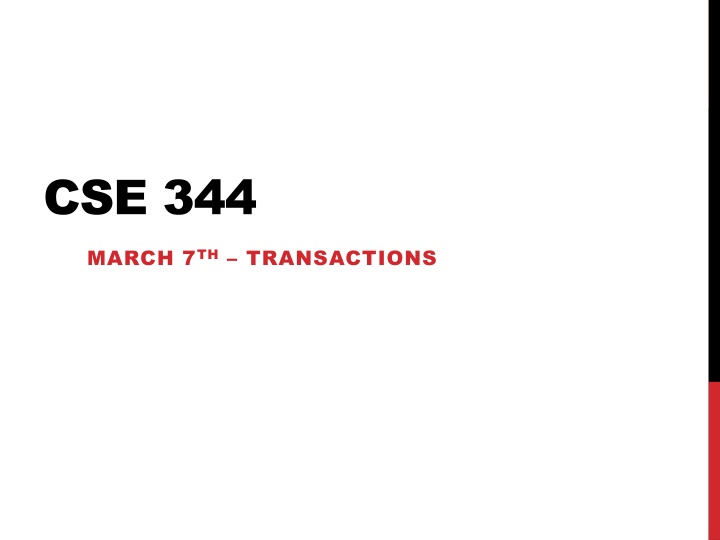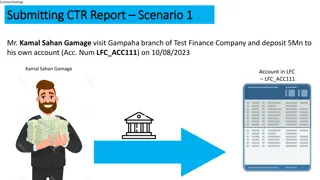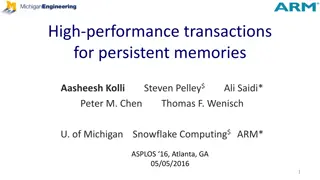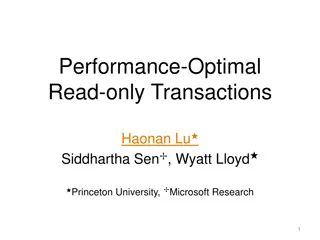
Database Transactions and Challenges in System Performance
Explore the importance of database transactions in everyday activities such as online shopping and bank transfers. Learn about challenges in executing multiple applications concurrently and the significance of ACID properties. Understand the concept of serial schedules and examples of transaction executions in a database system.
Download Presentation

Please find below an Image/Link to download the presentation.
The content on the website is provided AS IS for your information and personal use only. It may not be sold, licensed, or shared on other websites without obtaining consent from the author. If you encounter any issues during the download, it is possible that the publisher has removed the file from their server.
You are allowed to download the files provided on this website for personal or commercial use, subject to the condition that they are used lawfully. All files are the property of their respective owners.
The content on the website is provided AS IS for your information and personal use only. It may not be sold, licensed, or shared on other websites without obtaining consent from the author.
E N D
Presentation Transcript
CSE 344 MARCH 7TH TRANSACTIONS
ADMINISTRIVIA HW7 Due Tonight 11:30 HW8 Due Monday Max Two Late days Exam Review Sunday: 5pm EEB 045 Section tomorrow Fair game for final slides posted
TRANSACTIONS We use database transactions everyday Bank $$$ transfers Online shopping Signing up for classes For this class, a transaction is a series of DB queries Read / Write / Update / Delete / Insert Unit of work issued by a user that is independent from others
CHALLENGES Want to execute many apps concurrently All these apps read and write data to the same DB Simple solution: only serve one app at a time What s the problem? Want: multiple operations to be executed atomically over the same DBMS
ACID Atomic Consistent Isolated Durable Again: by default each statement is its own txn Unless auto-commit is off then each statement starts a new txn
SERIAL SCHEDULE A serial schedule is one in which transactions are executed one after the other, in some sequential order Fact: nothing can go wrong if the system executes transactions serially (up to what we have learned so far) But DBMS don t do that because we want better overall system performance
A and B are elements in the database t and s are variables in txn source code EXAMPLE T1 READ(A, t) t := t+100 WRITE(A, t) READ(B, t) t := t+100 WRITE(B,t) T2 READ(A, s) s := s*2 WRITE(A,s) READ(B,s) s := s*2 WRITE(B,s)
EXAMPLE OF A (SERIAL) SCHEDULE T1 READ(A, t) t := t+100 WRITE(A, t) READ(B, t) t := t+100 WRITE(B,t) Time T2 READ(A,s) s := s*2 WRITE(A,s) READ(B,s) s := s*2 WRITE(B,s)
ANOTHER SERIAL SCHEDULE T1 T2 READ(A,s) s := s*2 WRITE(A,s) READ(B,s) s := s*2 WRITE(B,s) Time READ(A, t) t := t+100 WRITE(A, t) READ(B, t) t := t+100 WRITE(B,t)
REVIEW: SERIALIZABLE SCHEDULE A schedule is serializable if it is equivalent to a serial schedule
A SERIALIZABLE SCHEDULE T1 READ(A, t) t := t+100 WRITE(A, t) T2 READ(A,s) s := s*2 WRITE(A,s) READ(B, t) t := t+100 WRITE(B,t) READ(B,s) s := s*2 WRITE(B,s) This is a serializable schedule. This is NOT a serial schedule
A NON-SERIALIZABLE SCHEDULE T1 READ(A, t) t := t+100 WRITE(A, t) T2 READ(A,s) s := s*2 WRITE(A,s) READ(B,s) s := s*2 WRITE(B,s) READ(B, t) t := t+100 WRITE(B,t)
HOW DO WE KNOW IF A SCHEDULE IS SERIALIZABLE? Notation: T1: r1(A); w1(A); r1(B); w1(B) T2: r2(A); w2(A); r2(B); w2(B) Key Idea: Focus on conflicting operations
CONFLICTS Write-Read WR Read-Write RW Write-Write WW Read-Read?
CONFLICT SERIALIZABILITY Conflicts: (i.e., swapping will change program behavior) ri(X); wi(Y) Two actions by same transaction Ti: Two writes by Ti, Tj to same element wi(X); wj(X) wi(X); rj(X) Read/write by Ti, Tj to same element ri(X); wj(X)
CONFLICT SERIALIZABILITY A schedule is conflict serializable if it can be transformed into a serial schedule by a series of swappings of adjacent non-conflicting actions Every conflict-serializable schedule is serializable The converse is not true (why?)
CONFLICT SERIALIZABILITY Example: r1(A); w1(A); r2(A); w2(A); r1(B); w1(B); r2(B); w2(B)
CONFLICT SERIALIZABILITY Example: r1(A); w1(A); r2(A); w2(A); r1(B); w1(B); r2(B); w2(B) r1(A); w1(A); r1(B); w1(B); r2(A); w2(A); r2(B); w2(B)
CONFLICT SERIALIZABILITY Example: r1(A); w1(A); r2(A); w2(A); r1(B); w1(B); r2(B); w2(B) r1(A); w1(A); r2(A); r1(B); w2(A); w1(B); r2(B); w2(B) r1(A); w1(A); r1(B); r2(A); w2(A); w1(B); r2(B); w2(B) . r1(A); w1(A); r1(B); w1(B); r2(A); w2(A); r2(B); w2(B)
TESTING FOR CONFLICT- SERIALIZABILITY Precedence graph: A node for each transaction Ti, An edge from Ti to Tj whenever an action in Ti conflicts with, and comes before an action in Tj The schedule is conflict-serializable iff the precedence graph is acyclic
EXAMPLE 1 r2(A); r1(B); w2(A); r3(A); w1(B); w3(A); r2(B); w2(B) 1 2 3
EXAMPLE 1 r2(A); r1(B); w2(A); r3(A); w1(B); w3(A); r2(B); w2(B) B A 1 2 3 This schedule is conflict-serializable
EXAMPLE 2 r2(A); r1(B); w2(A); r2(B); r3(A); w1(B); w3(A); w2(B) 1 2 3
EXAMPLE 2 r2(A); r1(B); w2(A); r2(B); r3(A); w1(B); w3(A); w2(B) B A 1 2 3 B This schedule is NOT conflict-serializable
SCHEDULER Scheduler = the module that schedules the transaction s actions, ensuring serializability Also called Concurrency Control Manager We discuss next how a scheduler may be implemented
IMPLEMENTING A SCHEDULER Major differences between database vendors Locking Scheduler Aka pessimistic concurrency control SQLite, SQL Server, DB2 Multiversion Concurrency Control (MVCC) Aka optimistic concurrency control Postgres, Oracle: Snapshot Isolation (SI) We discuss only locking schedulers in this class
LOCKING SCHEDULER Simple idea: Each element has a unique lock Each transaction must first acquire the lock before reading/writing that element If the lock is taken by another transaction, then wait The transaction must release the lock(s) By using locks scheduler ensures conflict-serializability
WHAT DATA ELEMENTS ARE LOCKED? Major differences between vendors: Lock on the entire database SQLite Lock on individual records SQL Server, DB2, etc
CASE STUDY: SQLITE SQLite is very simple More info: http://www.sqlite.org/atomiccommit.html Lock types READ LOCK (to read) RESERVED LOCK (to write) PENDING LOCK (wants to commit) EXCLUSIVE LOCK (to commit)
SQLITE Step 1: when a transaction begins Acquire a READ LOCK (aka "SHARED" lock) All these transactions may read happily They all read data from the database file If the transaction commits without writing anything, then it simply releases the lock
SQLITE Step 2: when one transaction wants to write Acquire a RESERVED LOCK May coexists with many READ LOCKs Writer TXN may write; these updates are only in main memory; others don't see the updates Reader TXN continue to read from the file New readers accepted No other TXN is allowed a RESERVED LOCK
SQLITE Step 3: when writer transaction wants to commit, it needs exclusive lock, which can t coexists with read locks Acquire a PENDING LOCK May coexists with old READ LOCKs Why not write to disk right now? No new READ LOCKS are accepted Wait for all read locks to be released
SQLITE Step 4: when all read locks have been released Acquire the EXCLUSIVE LOCK Nobody can touch the database now All updates are written permanently to the database file Release the lock and COMMIT
SQLITE first write commit requested no more read locks begin transaction RESERVED LOCK PENDING LOCK EXCLUSIVE LOCK READ LOCK None commit commit executed
SCHEDULE ANOMALIES What could go wrong if we didn t have concurrency control: Dirty reads (including inconsistent reads) Unrepeatable reads Lost updates Many other things can go wrong too
DIRTY READS Write-Read Conflict T1: WRITE(A) T2: READ(A) T1: ABORT
INCONSISTENT READ Write-Read Conflict T1: A := 20; B := 20; T1: WRITE(A) T2: READ(A); T2: READ(B); T1: WRITE(B)
UNREPEATABLE READ Read-Write Conflict T2: READ(A); T1: WRITE(A) T2: READ(A);
LOST UPDATE Write-Write Conflict T1: READ(A) T2: READ(A); T1: A := A+5 T2: A := A*1.3 T1: WRITE(A) T2: WRITE(A);
MORE NOTATIONS Li(A) = transaction Ti acquires lock for element A Ui(A) = transaction Ti releases lock for element A
A NON-SERIALIZABLE SCHEDULE T1 READ(A) A := A+100 WRITE(A) T2 READ(A) A := A*2 WRITE(A) READ(B) B := B*2 WRITE(B) READ(B) B := B+100 WRITE(B)
EXAMPLE T1 L1(A); READ(A) A := A+100 WRITE(A); U1(A); L1(B) T2 L2(A); READ(A) A := A*2 WRITE(A); U2(A); L2(B); BLOCKED READ(B) B := B+100 WRITE(B); U1(B); GRANTED; READ(B) B := B*2 WRITE(B); U2(B); Scheduler has ensured a conflict-serializable schedule
BUT T1 L1(A); READ(A) A := A+100 WRITE(A); U1(A); T2 L2(A); READ(A) A := A*2 WRITE(A); U2(A); L2(B); READ(B) B := B*2 WRITE(B); U2(B); L1(B); READ(B) B := B+100 WRITE(B); U1(B); Locks did not enforce conflict-serializability !!! What s wrong ?
TWO PHASE LOCKING (2PL) The 2PL rule: In every transaction, all lock requests must precede all unlock requests
EXAMPLE: 2PL TRANSACTIONS T1 L1(A); L1(B); READ(A) A := A+100 WRITE(A); U1(A) T2 L2(A); READ(A) A := A*2 WRITE(A); L2(B); BLOCKED READ(B) B := B+100 WRITE(B); U1(B); GRANTED; READ(B) B := B*2 WRITE(B); U2(A); U2(B); Now it is conflict-serializable
TWO PHASE LOCKING (2PL) Theorem: 2PL ensures conflict serializability
TWO PHASE LOCKING (2PL) Theorem: 2PL ensures conflict serializability Proof. Suppose not: then there exists a cycle in the precedence graph. C T1 T3 B A T2
TWO PHASE LOCKING (2PL) Theorem: 2PL ensures conflict serializability Proof. Suppose not: then there exists a cycle in the precedence graph. Then there is the following temporal cycle in the schedule: C T1 T3 B A T2
TWO PHASE LOCKING (2PL) Theorem: 2PL ensures conflict serializability Proof. Suppose not: then there exists a cycle in the precedence graph. Then there is the following temporal cycle in the schedule: U1(A) L2(A) why? C T1 T3 U1(A) happened strictly before L2(A) B A T2
TWO PHASE LOCKING (2PL) Theorem: 2PL ensures conflict serializability Proof. Suppose not: then there exists a cycle in the precedence graph. Then there is the following temporal cycle in the schedule: U1(A) L2(A) why? C T1 T3 B A T2






















